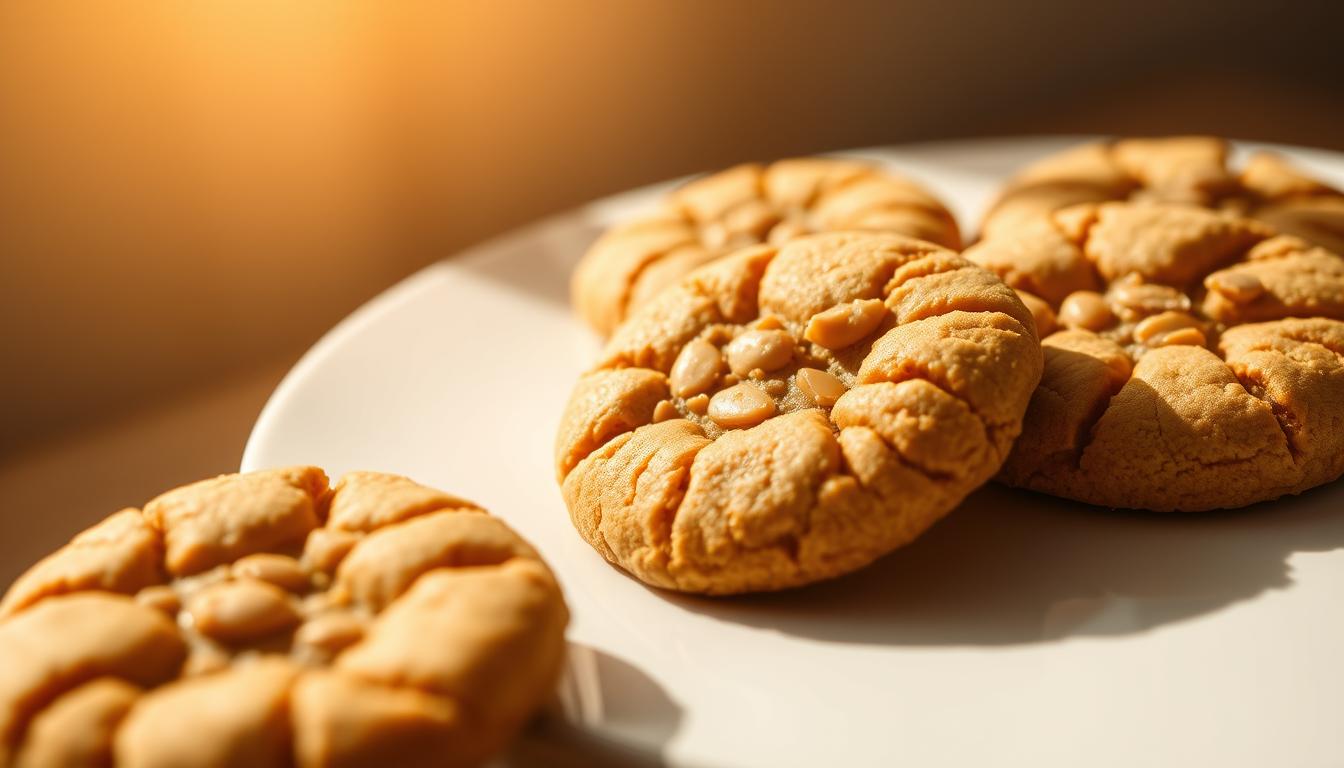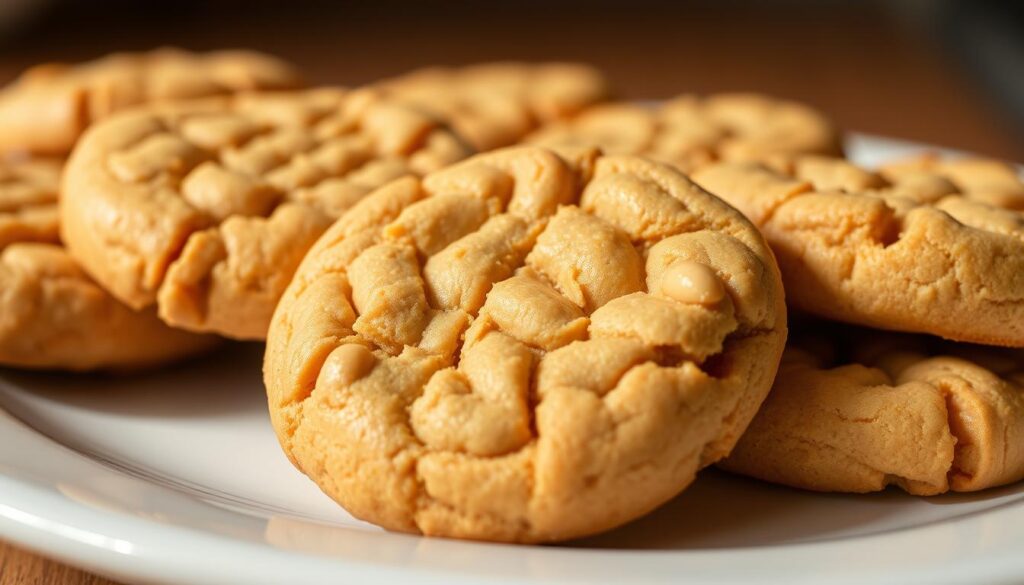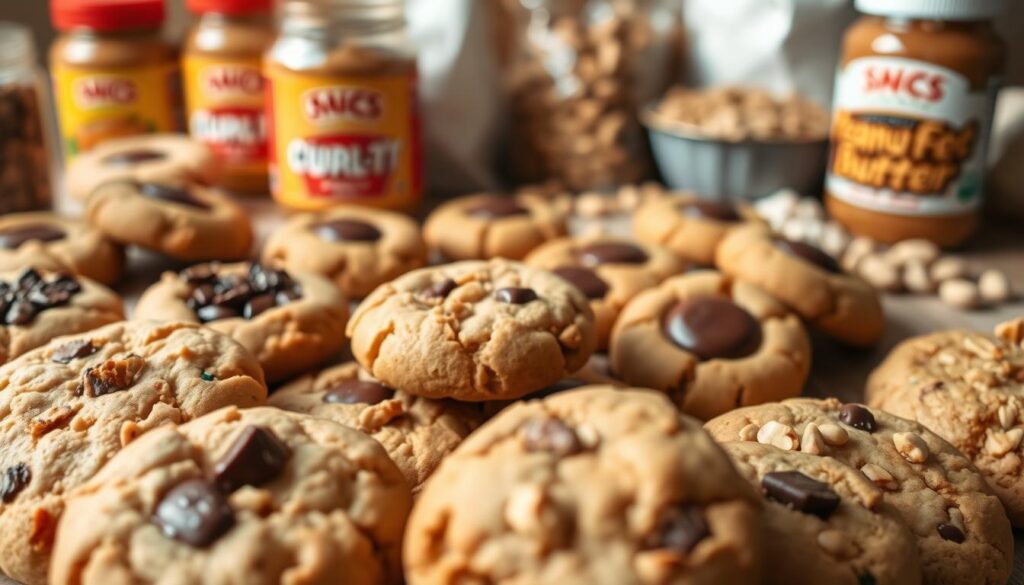
peanut butter cookies
Looking for a simple yet irresistible treat? These peanut butter cookies blend rich nutty flavor with the classic sweetness of sugar cookies. Perfect for any occasion, they require no chilling and bake in just 30 minutes.
After weeks of testing, we perfected this recipe to deliver bakery-quality results every time. The texture is a dream—crisp edges with a soft, chewy center. Whether for holidays, gifts, or ice cream sandwiches, these cookies always impress.
Skip the long prep! Our no-fail method ensures consistent results, making it ideal for busy bakers. Plus, they’re versatile—decorate them for Christmas, Valentine’s Day, or the 4th of July. Everyone raves about them!
Key Takeaways
- No-chill dough saves time—ready in 30 minutes.
- Perfect texture: crisp outside, soft inside.
- Great for holidays, gifts, or pairing with ice cream.
- Tested recipe guarantees bakery-level quality.
- Free baking guide included for best results.
Introduction to Peanut Butter Sugar Cookies
American baking took a bold turn when peanut butter met sugar cookies. Originally, cream cheese versions dominated, but their dense texture left bakers wanting more. A bakery’s flawless batch inspired the switch—peanut butter added richness while keeping the dough light.
The result? A *satisfying chew* with *melt-in-mouth* crumbles. Unlike traditional recipes, this version stays fresh longer, thanks to peanut butter’s natural oils. Home bakers and pros alike praise its versatility—decorate it for holidays or enjoy it plain.
Why Peanut Butter Works
Adding peanut butter to cookie dough does more than enhance flavor. It binds butter and flour evenly, preventing clumps. The fats create a tender crumb, while proteins add structure. Here’s how it compares nutritionally:
| Ingredient | Classic Recipe | Peanut Butter Version |
|---|---|---|
| Fat (per serving) | 8g | 10g |
| Protein | 2g | 4g |
| Shelf Life | 3 days | 5 days |
Allergy concerns? Swap peanut butter for almond butter or sunflower seed spread. The dough adapts beautifully—just adjust liquids slightly for perfect consistency.
Why You’ll Love This Sugar Cookie Recipe
What makes these cookies stand out from the rest? They strike the ideal balance between sweet and nutty, with a texture that’s crisp yet tender. Plus, they’re ready in under 30 minutes—no chilling needed.
Perfect Balance of Sweet and Nutty
The magic lies in the ratio of *granulated sugar* to peanut butter. Sugar enhances crispness, while peanut proteins add depth. A pinch of baking powder ensures a light, airy crumb.
No Chilling Required
Skip the wait! Unlike traditional dough, this version holds its shape at 67°F. Use a stand mixer for even blending, and roll 3-tbsp portions for uniform baking.
Versatile for Any Occasion
Dress them up or keep them simple. A cookie cutter transforms them into holiday shapes, or pair them with ice cream for a decadent dessert. Kid-friendly and budget-conscious, they’re a crowd-pleaser year-round.
Ingredients for Peanut Butter Sugar Cookies
Great baking starts with quality ingredients—here’s what you’ll need. Precision matters, so measure carefully for the ideal crisp-chewy balance.
Dry Ingredients
Start with flour—2½ cups (318g) of all-purpose. For accuracy, weigh it or spoon it into a measuring cup. Level off excess with a knife.
Add 2 tsp baking powder. Test its freshness by mixing ½ tsp with hot water. Bubbles mean it’s active. A pinch of salt (¾ tsp) enhances flavor. Sea salt offers subtle minerality; table salt disperses evenly.
Wet Ingredients
Use 2 sticks (226g) of unsalted butter at 67°F—cool but pliable. This temp prevents over-spreading. Cream it with 1¼ cups sugar until fluffy. Granulated sugar ensures crisp edges; brown sugar adds chew.
1 large egg binds the dough. Its proteins create structure. Add 1 tsp vanilla extract—pure versions offer richer flavor than imitation.
Peanut Butter Addition
Natural peanut butter yields a denser texture; processed blends smoothly. For allergies, try sunflower seed butter (reduce liquids by 1 tbsp). Fold in 1 cup gently to avoid overmixing.
- Pro tip: Chill dough 10 minutes if sticky.
- Science note: Peanut fats keep cookies moist longer.
Essential Baking Tools
The right tools can make or break your baking experience. Investing in quality equipment ensures even mixing, uniform shapes, and perfect bakes. Here’s what you need to master these treats.
Stand Mixer vs. Hand Mixer
A stand mixer saves time and effort, especially for thick dough. Its powerful motor blends ingredients evenly, preventing overworking. Hand mixers work for smaller batches but require more attention.
Choosing the Right Baking Sheet
Light aluminum sheets distribute heat evenly, reducing burnt edges. Avoid dark pans—they absorb too much heat. For best results, use a rimmed sheet to prevent spills.
Cookie Scoop for Uniform Shapes
A 3-tbsp scoop ensures evenly sized treats. This guarantees consistent baking times. Ergonomic designs reduce hand strain during large batches.
Pair your sheet with a silicone mat or parchment paper. Both prevent sticking, but mats offer reusable convenience. Test conductivity—silicone slows browning slightly.
Store dough in an airtight container if prepping ahead. Wrap it in plastic wrap to lock in moisture. Chill for 10 minutes if sticky before shaping.
Step-by-Step Instructions
Mastering the perfect batch starts with precise steps. Follow this guide to create treats with crisp edges and chewy centers—every time.
Mixing the Dough
Begin by creaming butter and sugar in a mixer for 2–3 minutes. Scrape sides of the bowl halfway to ensure even blending. The mix should turn pale and fluffy.
Add the egg and vanilla, mixing just until combined. Overworking here can toughen the dough. Pro tip: Chill wet ingredients briefly if your kitchen is warm.
Incorporating Peanut Butter
Fold in peanut butter at temperature (67°F). Too cold, and it won’t blend smoothly; too warm, and the dough spreads excessively. Use a spatula to integrate it gently.
For uniform texture, sift dry ingredients beforehand. Add them in two batches, mixing on low speed. Stop when streaks of flour disappear.
| Dough Hydration Tips | Solution |
|---|---|
| Too sticky | Add 1 tbsp flour |
| Too dry | Sprinkle 1 tsp milk |
| Perfect | Holds shape when rolled |
Rolling and Shaping the Cookies
Portion dough with a 3-tbsp scoop for consistency. Roll balls lightly in granulated sugar—this controls moisture for a crackled top. Space them 2″ apart on the sheet.
Flatten slightly with a fork for classic ridges. Let dough rest 5 minutes before baking to reduce spreading. Bake at 350°F for 10–12 minutes until edges golden.
Baking Tips for Perfect Cookies
Achieving bakery-quality results at home requires mastering a few key techniques. From oven calibration to visual cues, these strategies ensure golden edges and tender centers every time.

Preheating the Oven
Always preheat oven to 350°F for 15–20 minutes. Use an oven thermometer—many appliances run hotter or cooler than displayed. For even heat, avoid overcrowding racks.
Cold spots? Rotate pans halfway through baking. At high altitudes, reduce temperature by 15°F to prevent over-spreading.
Checking for Doneness
Bake for 10–12 minutes. Look for lightly browned edges while centers remain soft. They firm up during cooling due to carryover cooking.
Press the center gently—it should spring back slightly. Underbaked? Return to the oven for 1-minute increments.
Avoiding Over-Spreading
Butter at 67°F is ideal—too warm, and dough flattens. Chill sticky dough for 10 minutes before shaping. Space portions 2″ apart on cool pans.
| Issue | Solution |
|---|---|
| Thin cookies | Add 2 tbsp flour |
| Pale bottoms | Use light-colored pans |
| Uneven browning | Rotate pans at 5-minute mark |
For crispier results, bake 1–2 minutes longer. Store cooled treats in airtight containers to preserve texture.
Decorating Your Peanut Butter Sugar Cookies
Transform your baked treats into edible art with these easy decorating ideas. Whether you prefer minimalist elegance or vibrant designs, a few techniques can turn homemade goods into showstoppers.
Simple Sugar Coating
Roll dough balls in granulated sugar before baking for a sparkling finish. The sugar crystallizes during baking, creating a delicate crunch. For extra shimmer, use coarse or sanding sugar.
Using Colored Sugars or Sprinkles
Add festive flair with colored sugars or sprinkles. Apply them right after baking while the surface is slightly sticky. Pro tip: Mix sprinkles with a pinch of cornstarch to prevent clumping.
- Timing matters: Add sprinkles within 2 minutes of removing from the oven.
- Color intensity: Gel food coloring blends more vibrantly than liquid.
Drizzling with Chocolate
Melt dark, milk, or white chocolate (110°F for ideal viscosity) and drizzle with a fork or piping bag. Let it set at room temperature for a glossy finish. Pair with sea salt for a sweet-salty contrast.
“Decorating is the fun part—don’t overthink it. Even uneven drizzles look artisanal.”
For structured designs, use buttercream or royal icing. Thin icing floods surfaces, while thicker consistency holds peaks. Match flavors—vanilla complements nuttiness, while citrus zest brightens richness.
Storing and Freezing Instructions
Keep your treats fresh and ready with these expert storage methods. Whether you’re prepping ahead or saving leftovers, proper techniques lock in flavor and texture.
Room Temperature Storage
For short-term storage, place cooled treats in an airtight container with parchment layers. They’ll stay fresh for up to 3 days at 68°F. Add a bread slice to absorb excess moisture without drying them out.
Freezing Cookie Dough
Portion dough into balls before freezing for easy baking later. Wrap each tightly in plastic wrap, then seal in freezer bags. Label with the date—they’ll keep for 3 months at 0°F.
“Flash-freeze dough balls on a tray first to prevent sticking. It’s a game-changer for last-minute baking.”
Freezing Baked Cookies
Fully cooled treats freeze beautifully in rigid containers. Separate layers with wax paper to prevent ice crystals. Thaw at room temperature for 30 minutes before serving.
| Storage Method | Duration | Texture Preservation |
|---|---|---|
| Room Temperature | 3 days | Soft center, crisp edge |
| Frozen Dough | 3 months | Bakes like fresh |
| Frozen Baked | 2 months | Requires 5-min reheat |
For commercial kitchens, maintain logs with batch dates. Home bakers can use colored tape for quick identification. Always check for freezer burn before use.
Variations and Substitutions
Customize your baking with these flexible twists on a classic favorite. Whether accommodating dietary needs or experimenting with flavors, these adjustments ensure everyone enjoys the treat.

Gluten-Free Option
Swap all-purpose flour with a 1:1 gluten-free blend. Look for mixes containing xanthan gum—it mimics gluten’s binding properties. For best texture, add ½ tsp powder per cup of flour.
Almond or oat flour works too, but reduce liquids by 1 tbsp. Test a small batch first—absorbancy varies by brand.
Using Natural Peanut Butter
Natural peanut butter’s oil separation can alter dough consistency. Stir it thoroughly before measuring, or opt for no-stir brands. If dough feels greasy, chill it for 15 minutes.
For a deeper flavor, try roasted varieties. Avoid overly thick or dry textures—add 1 tsp milk if needed.
Adding Chocolate Chips
Fold in ¾ cup of chips after mixing the dough. Mini chips distribute evenly, while dark chocolate balances sweetness. For a festive touch, use seasonal colors.
“Mix-ins should complement, not overwhelm. Start with ½ cup and adjust to taste.”
- Nut-free? Sunflower seed butter pairs well with maple extract.
- Vegan? Use flax eggs and dairy-free chips.
Troubleshooting Common Issues
Even experienced bakers encounter hurdles—here’s how to solve them. Whether your treats spread too thin or crumble apart, these fixes restore perfection. We’ll tackle texture, shape, and consistency with pro-approved methods.
Cookies Too Flat
Butter that’s too warm causes excessive spreading. For dough that holds shape, use butter at 67°F—cool but pliable. Chill pans before baking for sharper edges.
Other fixes:
- Add 1–2 tbsp flour if dough feels sticky.
- Verify oven temperature with a thermometer.
- Space portions 2″ apart on cool sheets.
Dough Too Sticky
Humidity or mismeasured ingredients often cause this. Spoon flour into a measuring cup and level it—packing adds excess. If needed, chill dough for 10 minutes.
Pro tip: Natural peanut butter varies in oil content. Stir well before using, or reduce liquids by 1 tsp.
Cookies Too Dry
Overbaking or too much flour leads to crumbly results. Bake for the minimum time (10 minutes), then check. They firm up while cooling.
For rescue:
- Add 1 tsp milk or peanut butter to dough.
- Store baked treats with a bread slice to retain moisture.
“Baking is science. Small adjustments—like 5°F oven tweaks—make big differences.”
Conclusion
Ready to take your baking skills to the next level? These sugar cookies prove that simplicity delivers stunning results—crisp edges, chewy centers, and endless versatility.
Make this recipe your own. Add chocolate chips, swap nut butters, or decorate for holidays. Share your creations with #handletheheat and inspire fellow bakers!
Want more pro tips? Explore our cookbook for advanced techniques. Every batch is a chance to learn, adapt, and create sweet memories.
FAQ
Can I use natural peanut butter for this recipe?
Yes, but it may alter the texture slightly. Natural versions often have more oil, so adjust flour if needed.
How do I prevent my cookies from spreading too much?
Chill the dough for 15–20 minutes before baking and ensure your oven is fully preheated to the right temperature.
Can I make these gluten-free?
Absolutely! Substitute all-purpose flour with a 1:1 gluten-free blend for similar results.
What’s the best way to store baked cookies?
Keep them in an airtight container at room temperature for up to 5 days or freeze for longer freshness.
Can I decorate these with icing?
Yes! A simple buttercream or royal icing pairs well, or try a drizzle of melted chocolate for extra flavor.
Why do my cookies turn out dry?
Overbaking or too much flour can cause dryness. Measure ingredients carefully and check doneness at the minimum bake time.
Is a stand mixer necessary?
No, a hand mixer works too. Just ensure ingredients are well blended for the best consistency.
Can I freeze the dough for later use?
Yes! Shape it into balls, freeze on a tray, then transfer to a bag. Bake straight from frozen, adding 1–2 extra minutes.